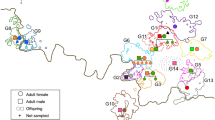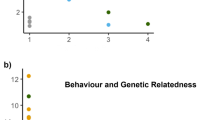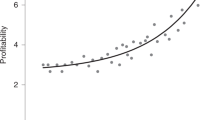Abstract
Mating strategies that lead to increased kinship within socially cooperative groups may offer inclusive fitness benefits to individuals1,2,3, but can also result in higher levels of inbreeding4,5,6. Here we show in a sexually segregated bat species that females avoid this conflict through two mating behaviours. First, most females revisit and breed with specific, individual males across years, so that their single offspring born in different years are full siblings. Second, relatives in the maternal line, including mothers and daughters, share breeding partners (intra-lineage polygyny) more often than expected by chance. Although these behaviours increased levels of co-ancestry among colony members, there was no concomitant rise in inbreeding. We suggest that when females engage in mate fidelity and intra-lineage polygyny, kin ties among female roost mates will be strengthened, thereby potentially contributing to social group cohesiveness. Our findings reveal the hidden complexity that can underlie polygynous breeding, and highlight a new potential route by which female mate choice could influence social evolution.
This is a preview of subscription content, access via your institution
Access options
Subscribe to this journal
Receive 51 print issues and online access
$199.00 per year
only $3.90 per issue
Buy this article
- Purchase on Springer Link
- Instant access to full article PDF
Prices may be subject to local taxes which are calculated during checkout


Similar content being viewed by others
References
Hamilton, W. D. The genetical evolution of social behaviour. J. Theor. Biol. 7, 1–52 (1964)
Hepper, P. G. in Kin Recognition (ed. Hepper, P. G.) 1–5 (Cambridge Univ. Press, Cambridge, 1991)
Chapais, B. & Berman, C. M. Kinship and Behavior in Primates (Oxford Univ. Press, New York, 2004)
Shields, W. M. Philopatry, Inbreeding, and the Evolution of Sex (State Univ. New York Press, Albany, 1982)
Pusey, A. E. Sex-biased dispersal and inbreeding avoidance in birds and mammals. Trends Ecol. Evol. 2, 295–299 (1987)
Reeve, H. K., Westneat, D. F., Noon, W. A., Sherman, P. W. & Aquadro, C. F. DNA fingerprinting reveals high levels of inbreeding in colonies of the eusocial naked mole-rat. Proc. Natl Acad. Sci. USA 87, 2496–2500 (1990)
Greenwood, P. J. Mating systems, philopatry and dispersal in birds and mammals. Anim. Behav. 28, 1140–1162 (1980)
Emlen, S. T. An evolutionary theory of the family. Proc. Natl Acad. Sci. USA 92, 8092–8099 (1995)
Andersson, M. Sexual Selection (Princeton Univ. Press, Princeton, 1994)
Clutton-Brock, T. H. Mammalian mating systems. Proc. R. Soc. Lond. B 236, 339–372 (1989)
McCracken, G. F. & Wilkinson, G. S. in Reproductive Biology of Bats (eds Crichton, E. G. & Krutzsch, P. H.) 321–362 (Academic, New York, 2000)
Ransome, R. D. in The Handbook of British Mammals 3rd edn (eds Corbet, G. B. & Harris, S.) 88–94 (Blackwell, Oxford, 1991)
Rossiter, S. J., Jones, G., Ransome, R. D. & Barratt, E. M. Relatedness, kin-biased foraging in the greater horseshoe bat Rhinolophus ferrumequinum. Behav. Ecol. Sociobiol. 51, 510–518 (2002)
Marshall, T. C., Slate, J., Kruuk, L. & Pemberton, J. M. Statistical confidence for likelihood-based paternity inference in natural populations. Mol. Ecol. 7, 639–655 (1998)
Amos, B., Twiss, S., Pomeroy, P. & Anderson, S. Evidence for mate fidelity in the gray seal. Science 268, 1897–1899 (1995)
Sandercock, B. K., Lank, D. B., Lanctot, R. B., Kempenaers, B. & Cooke, F. Ecological correlates of mate fidelity in two Arctic-breeding sandpipers. Can. J. Zool. 78, 1948–1958 (2000)
Chesser, R. K. Gene diversity and female philopatry. Genetics 127, 437–447 (1991)
Chesser, R. K. Influence of gene flow and breeding tactics on gene diversity within populations. Genetics 129, 573–583 (1991)
Sugg, D. W., Chesser, R. K., Dobson, F. S. & Hoogland, J. L. Population genetics meets behavioural ecology. Trends Ecol. Evol. 11, 338–342 (1996)
Storz, J. F. Genetic consequences of mammalian social structure. J. Mammal. 80, 553–569 (1999)
Rossiter, S. J., Jones, G., Ransome, R. D. & Barratt, E. M. Parentage, reproductive success and breeding behaviour in the greater horseshoe bat (Rhinolophus ferrumequinum). Proc. R. Soc. Lond. B 267, 545–551 (2000)
Griffin, A. S. & West, S. A. Kin discrimination and the benefit of helping in cooperatively breeding vertebrates. Science 302, 634–636 (2003)
Wilkinson, G. S. Reciprocal food sharing in the vampire bat. Nature 308, 181–184 (1984)
Bush, G. L., Case, S. M., Wilson, A. C. & Patton, J. L. Rapid speciation and chromosomal evolution in mammals. Proc. Natl Acad. Sci. USA 74, 3942–3946 (1977)
Ransome, R. D. Earlier breeding shortens life in female greater horseshoe bats. Phil. Trans. R. Soc. Lond. B 350, 153–161 (1995)
Rossiter, S. J., Burland, T. M., Jones, G. & Barratt, E. M. Characterization of microsatellite loci in the greater horseshoe bat Rhinolophus ferrumequinum. Mol. Ecol. 8, 1957–1969 (1999)
Dawson, D. A., Rossiter, S. J., Jones, G. & Faulkes, C. G. Microsatellite loci for the greater horseshoe bat, Rhinolophus ferrumequinum (Rhinolophidae, Chiroptera) and their cross-utility in 17 other bat species. Mol. Ecol. Notes 4, 96–100 (2004)
Rossiter, S. J., Jones, G., Ransome, R. D. & Barratt, E. M. Genetic variation and population structure in the endangered greater horseshoe bat (Rhinolophus ferrumequinum). Mol. Ecol. 9, 1131–1135 (2000)
Marshall, T. C. et al. Estimating the prevalence of inbreeding from incomplete pedigrees. Proc. R. Soc. Lond. B 266, 1533–1539 (2002)
Acknowledgements
We thank the Woodchester Mansion Trust for access to the roost and the many volunteers who helped with data collection. We thank T. Burland, D. Dawson, B. Manley, C. Mein and R. Nichols for advice and technical support, and A. Bourke, A. Hildrew, R. Nichols, A. Overall, D. Polly and F. Ratnieks for helpful comments on an earlier version of the manuscript. Bats were caught and sampled under license from English Nature and the Home Office. This work was funded by the Natural Environment Research Council (NERC), and microsatellite development was supported by the NERC Sheffield Molecular Genetics Facility. Author Contributions S.J.R. conceived the project with G.J., undertook the laboratory work and wrote the paper. R.D.R. undertook most of the fieldwork with help from G.J. S.J.R. and C.G.F. jointly analysed the pedigree and genetic data, and S.L.C. wrote the computer programs to implement the randomizations and statistical tests.
Author information
Authors and Affiliations
Corresponding author
Ethics declarations
Competing interests
Reprints and permissions information is available at npg.nature.com/reprintsandpermissions. The authors declare no competing financial interests.
Supplementary information
Supplementary Methods
Randomisation tests and power analysis. (RTF 7 kb)
Rights and permissions
About this article
Cite this article
Rossiter, S., Ransome, R., Faulkes, C. et al. Mate fidelity and intra-lineage polygyny in greater horseshoe bats. Nature 437, 408–411 (2005). https://doi.org/10.1038/nature03965
Received:
Accepted:
Issue Date:
DOI: https://doi.org/10.1038/nature03965
This article is cited by
-
Close-kin mark-recapture informs critically endangered terrestrial mammal status
Scientific Reports (2023)
-
Long-term field studies in bat research: importance for basic and applied research questions in animal behavior
Behavioral Ecology and Sociobiology (2022)
-
Urinary creatinine varies with microenvironment and sex in hibernating Greater Horseshoe bats (Rhinolophus ferrumequinum) in Korea
BMC Ecology and Evolution (2021)
-
Genetic evidence for sex-biased dispersal and cryptic diversity in the greater horseshoe bat, Rhinolophus ferrumequinum
Biodiversity and Conservation (2021)
-
Vocalization during copulation behavior in greater horseshoe bats, Rhinolophus ferrumequinum
Chinese Science Bulletin (2013)
Comments
By submitting a comment you agree to abide by our Terms and Community Guidelines. If you find something abusive or that does not comply with our terms or guidelines please flag it as inappropriate.



